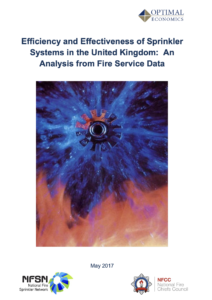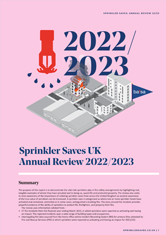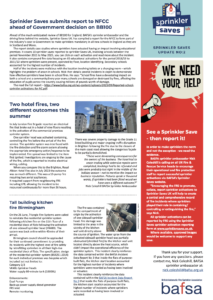
- This event has passed.
LFB Reported Sprinkler Activations October – November 2023
1 October 2023 - 30 November 2023

A London Fire Brigade spokesperson said: “The numbers of buildings in London with sprinklers systems are still very low and we would like to see this increase. Automatic Fire Suppression Systems, like sprinklers, alongside other fire safety measures can greatly reduce the impact of fires on people, property, homes, and communities. “Sprinklers are not a luxury – they save lives and also reduce risk to the firefighters who have to tackle the fires.”
- The continued support, commitment of The London Fire Brigade, (LFB) reporting real, tangible examples of where Automatic Fire Suppressions (AFSS) have actuated within the capital and in doing so saved life and protected property should not be underestimated. The story around the incident provides powerful evidence of the ability of sprinklers to protect life, firefighters, and property from fire.
- Promoting the benefits of sprinklers, sprinkler activations will encourage housing providers, stakeholders and partners, and others to install Automatic Fire Suppression Systems to protect the most vulnerable residents from fire within Greater London throughout the United Kingdom.
For the period October-November 2023, 10 activations were reported by the LFB to Sprinkler Saves UK covering a range of buildings, occupancies.
On each occasion it is reported
- The premises AFSS activated and raised the alarm.
- Of the 10 activations 7 fires were extinguished with no further firefighting required by operational crews on arrival.
- The remaining 3 fires were contained, controlled by operational crews using extinguishing media.
- ¹Further evidence, Supporting the most recent UK research was commissioned by The National Fire Chiefs Council (NFCC), National Fire Sprinkler Network (NFSN) and supported by BAFSA in the publication, “Efficiency and Effectiveness of Sprinkler Systems in the United Kingdom: An Analysis from Fire Service Data”.
- Across all premises types:
Sprinklers are 99% efficient in extinguishing or controlling a fire.
Sprinklers are 94% efficient in their ability to operate. - It cannot be stressed how important active systems are, they should not be viewed as an alternative to passive fire protection systems. Providing effective fire protection requires both passive and active elements working in unison and complementing the roles of one another. The use of a combined approach allowing the occupants of exiting the building safely/damage to the property is minimized.
- AFSS play a significant role, as part of an appropriate package of fire safety measures reducing the impact of fire on people, property, and the environment
October Sprinkler Case Studies
- Customer Fulfilment Centre (CFC) Fire
- Occupancy; Commercial
- Where; Bexley
- When; 9 October 2023
- Time of call; 09:41
- Incident; Batteries, generators, faulty fuel supplies-electricity
- AFSS; Sprinklers
A fire on the ground floor of a 5 storey CFC was extinguished by the activation of the commercial sprinkler system, demonstrating the effectiveness of a suppression system as part of a holistic approach containing, controlling or in this case extinguishing the fire with no further firefighting media required upon the arrival of the Fire Rescue Service. (FRS) Sprinklers not only protect lives, but they also protect property, businesses, and jobs. This was the second reported fire at this premises within 30 months on both occasions the sprinkler system activated extinguishing the fire.
- Mental Health Hospital Fire
- Occupancy; Commercial
- Where; Wandsworth
- When; 12 October 2023
- To call; 21:04
- Incident; Arson, malicious
- AFSS; Sprinklers
Fire safety is a concern across the National Health Service (NHS)mental health services are especially vulnerable as they must deal with fires caused by patients who are disorganised by illness or have fire setting tendencies. There are no statutory requirements for sprinklers to be provided in hospitals except for certain high-rise buildings and certain commercial enterprises contained within hospitals. This incident demonstrates the benefits of sprinklers for mental health service premises, on arrival operational crews identified that a fire within a room had been extinguished by the activation of one sprinkler head. The cause of the fire was identified as a malicious act.
It should be remembered the installation of a life safety AFSS is to reduce the rate of heat and smoke, allowing more time for the occupants to escape to safety or be rescued.
- Tall Building Fire
- Occupancy; Residential
- Where, Southwark
- When; 14 October 2023
- Time of call; 04:06
- Use of building; Purpose Built Flats/Maisonettes – 10 or more storeys.
- Number of floors; 36
- Location of fire; Kitchen
- AFSS; Sprinklers
The alarm was raised following a fire involving smoking materials activating the residential sprinkler system within a kitchen. Two sprinkler heads activated controlling, extinguishing the fire to the room of origin, no further firefighting was required.
- Recycling Plant Fire
- Occupancy; Industrial
- Where, Crayford
- When; 25 October 2023
- Time of call; 09:22
- Use of building; Recycling Plant
- Location of fire; Paper Compactor
- AFSS; Drencher
A fire involving a paper compactor on the ground floor was contained, controlled by the premises drencher system which activated following a fire involving combustible materials located to close to a heat source. The fire was extinguished by operational crews using a hose reel jet.
- Self-Contained Sheltered Housing Fire
- Occupancy; Residential
- Where, Brent
- When; 29 October 2023
- Time of call; 00:55
- Use of building; Residential
- Location of fire; flat, Kitchen
- AFSS; Sprinklers
On arrival operational crews identified a fire within a kitchen of a ground plus 2 terraced property involving cooking which had been extinguished by the activation of one sprinkler head no further firefighting was required with total fire damage up to 5sqm no injuries were reported.
- Museum Fire
- Occupancy; Commercial
- Where, Westminster
- When; 31 October 2023
- Time of call; 13:44
- Use of building; Museum
- Location of fire; Refuse/storeroom
- AFSS; Sprinklers
A fire involving the accumulation of flammable material within a refuse room was extinguished by the activation of three sprinkler heads with fire spread limited to item first ignited. The importance of protecting heritage buildings, whether that’s a museum, gallery or historic buildings should not be underestimated fire sprinklers offer numerous benefits, reducing the risk of fire related damage, preserving not only the physical structure but also the irreplaceable treasures housed within.
November Sprinkler Case Studies
- Tall Building Fire
- Occupancy; Residential
- Where, Westminster
- When; 5 November 2023
- Time of call; 18:11
- Use of building; Purpose Built Flats/Maisonettes – 4 to 9 storeys.
- Location of fire; flat, utility room
- AFSS; Sprinklers
Five fire appliances were mobilised requiring 35 firefighters, the alarm was raised following the activation of the premises residential sprinkler system within a 11-storey residential block of flats. On arrival it was established that the fire was within a flat on the fourth floor of a nine-storey building which had been contained/controlled within the utility room by the sprinkler system. The fire was extinguished by crew using firefighting media. The cause of the fire was due to a defective washer dryer, no injuries were reported.
- Tall Building Fire
- Occupancy; Residential
- Where; Haringey
- When; 7 November 2023
- Time of call; 22:14
- Use of building; Purpose Built Flats/Maisonettes – 10 or more storeys
- Location of fire; Kitchen, flat
- AFSS; Sprinklers
On arrival operational crews identified a fire within a flat within a new purpose-built block of flats consisting of 12 stories involving a chip pan fire which had been extinguished by the activation of one sprinkler head. No further firefighting media was required. This incident clearly identifies the benefits of sprinklers involving chip pan fires, this is the Seventh incident reported to Sprinklersaves.co.uk putting the myth to bed that residential sprinklers as an extinguishing media should not be used on fires involving chip pans. On each occasion the fire was extinguished, contained/contained.
- Tall Building Fire
- Occupancy; Residential
- Where; Hammersmith and Fulham
- When; 24 November 2023
- Time of call; 03:31
- Use of building; Purpose Built Flats/Maisonettes – 10 or more storeys.
- Location of fire; Flat, private balcony
- AFSS; Sprinklers
In the early hours operational crews were mobilised to a balcony fire within a 14-storey residential block of flats which contained/controlled the fire to floor of origin, the fire was extinguished using firefighting media, main branch/jet. The cause of the fire was due to unsafe disposal of a cigarette. Following an external balcony fire at West Hampstead, on 3 July 2018 involving the actuation of multiple nozzle heads, LFB published a comprehensive study report to raise awareness in the residential sector of the beneficial/effectiveness impact that incorporating AFSS can have in a multi-point residential high-rise fire.
- Hotel Fire
- Occupancy; Commercial
- Where; City of London
- When; 24 November 2023
- Time of call; 19:09
- Use of building; Hotel/motel
- Location of fire; Bedroom
- AFSS; Sprinklers
A fire involving an electrical appliance, hair dryer within the bedroom of a 14-storey hotel resulted in the activation of 2 sprinkler heads which extinguished the fire, on arrival no further firefighting media was required by operational crews. Total fire damage up to 5sqm with the fire contained to room of origin.
If you hear of a save report it, it makes a difference……………


Links
- Sprinkler Saves Review 2022/2023
- Sprinkler Saves Update No 2
- ¹Efficiency and Effectiveness of Sprinkler Systems in the United Kingdom: An analysis from fire service data-Optimal economics repory May 2017
- Report a sprinkler save



